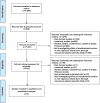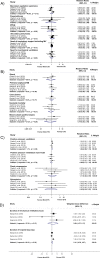Outcomes of endotracheal suctioning in non-vigorous neonates born through meconium-stained amniotic fluid: a systematic review and meta-analysis
- PMID: 32561566
- PMCID: PMC7788200
- DOI: 10.1136/archdischild-2020-318941
Outcomes of endotracheal suctioning in non-vigorous neonates born through meconium-stained amniotic fluid: a systematic review and meta-analysis
Abstract
Objective: We aimed to systematically review and analyse the outcomes of non-endotracheal suctioning (non-ETS) versus ETS in non-vigorous meconium-stained neonates.
Design: We conducted a systematic review of non-ETS and ETS in non-vigorous infants born through meconium-stained amniotic fluid (MSAF). We searched PubMed/Medline, Scopus, Clinical Trials.gov, Cumulative Index to Nursing and Allied Health, and Cochrane Library databases from inception to November 2019, using keywords and related terms. Only non-vigorous infants born through MSAF included in randomised controlled trials, were included. We calculated overall relative risks (RRs) and mean differences with 95% CIs using a random-effects model, to determine the impact of ETS in non-vigorous infants born through MSAF.
Main outcome measures: The primary outcome was the incidence of meconium aspiration syndrome (MAS). Secondary outcomes were respiratory outcome measures (pneumothorax, persistent pulmonary hypertension of the newborn, secondary pneumonia, need for respiratory support, duration of mechanical ventilation), initial resuscitation and others including shock, perinatal asphyxia, convulsions, neonatal mortality, blood culture-positive sepsis and duration of hospital stay.
Results: A total of 2085 articles were identified in the initial database search. Four studies, including 581 non-vigorous meconium-stained infants, fulfilled the inclusion criteria, comprising 292 infants in the non-ETS group and 289 in the ETS group. No statistically significant difference was found for MAS (RR 0.98; 95% CI 0.71 to 1.35).
Conclusions: Initiating ETS soon after birth in non-vigorous meconium-stained infants may not alter their neonatal outcomes.
Keywords: neonatology; paediatric practice.
© Author(s) (or their employer(s)) 2021. Re-use permitted under CC BY-NC. No commercial re-use. See rights and permissions. Published by BMJ.
Conflict of interest statement
Competing interests: None declared.
Figures


Similar articles
-
Tracheal suction at birth in non-vigorous neonates born through meconium-stained amniotic fluid.Cochrane Database Syst Rev. 2021 Jun 16;6(6):CD012671. doi: 10.1002/14651858.CD012671.pub2. Cochrane Database Syst Rev. 2021. PMID: 34133025 Free PMC article.
-
Routine Tracheal Intubation and Meconium Suctioning in Non-Vigorous Neonates with Meconium-Stained Amniotic Fluid: A Systematic Review and Meta-Analysis.Diagnostics (Basel). 2022 Apr 1;12(4):881. doi: 10.3390/diagnostics12040881. Diagnostics (Basel). 2022. PMID: 35453929 Free PMC article. Review.
-
Endotracheal suctioning for prevention of meconium aspiration syndrome: a randomized controlled trial.Eur J Pediatr. 2019 Dec;178(12):1825-1832. doi: 10.1007/s00431-019-03463-z. Epub 2019 Oct 7. Eur J Pediatr. 2019. PMID: 31588974 Clinical Trial.
-
Yield of meconium in non-vigorous neonates undergoing endotracheal suctioning and profile of all neonates born through meconium-stained amniotic fluid: a prospective observational study.Paediatr Int Child Health. 2018 Nov;38(4):266-270. doi: 10.1080/20469047.2018.1508809. Epub 2018 Aug 30. Paediatr Int Child Health. 2018. PMID: 30160618
-
Outcomes of Nonvigorous Neonates Born through Meconium-Stained Amniotic Fluid after a Practice Change to No Routine Endotracheal Suctioning from a Developing Country.Am J Perinatol. 2024 Jul;41(9):1163-1170. doi: 10.1055/a-1797-7005. Epub 2022 Mar 14. Am J Perinatol. 2024. PMID: 35288884
Cited by
-
Tracheal suction at birth in non-vigorous neonates born through meconium-stained amniotic fluid.Cochrane Database Syst Rev. 2021 Jun 16;6(6):CD012671. doi: 10.1002/14651858.CD012671.pub2. Cochrane Database Syst Rev. 2021. PMID: 34133025 Free PMC article.
-
Meconium Aspiration Syndrome: A Narrative Review.Children (Basel). 2021 Mar 17;8(3):230. doi: 10.3390/children8030230. Children (Basel). 2021. PMID: 33802887 Free PMC article. Review.
-
Routine Tracheal Intubation and Meconium Suctioning in Non-Vigorous Neonates with Meconium-Stained Amniotic Fluid: A Systematic Review and Meta-Analysis.Diagnostics (Basel). 2022 Apr 1;12(4):881. doi: 10.3390/diagnostics12040881. Diagnostics (Basel). 2022. PMID: 35453929 Free PMC article. Review.
-
Meconium aspiration syndrome: a comprehensive review.J Perinatol. 2023 Oct;43(10):1211-1221. doi: 10.1038/s41372-023-01708-2. Epub 2023 Aug 5. J Perinatol. 2023. PMID: 37543651 Review.
-
Outcomes of neonates born through meconium-stained amniotic fluid pre and post 2015 NRP guideline implementation.PLoS One. 2023 Aug 10;18(8):e0289945. doi: 10.1371/journal.pone.0289945. eCollection 2023. PLoS One. 2023. PMID: 37561740 Free PMC article.
References
-
- Mitchell S, Chandraharan E. Meconium-stained amniotic fluid. Obstet Gynaecol Reprod Med 2018;28:120–4. 10.1016/j.ogrm.2018.02.004 - DOI
Publication types
MeSH terms
LinkOut - more resources
Full Text Sources
